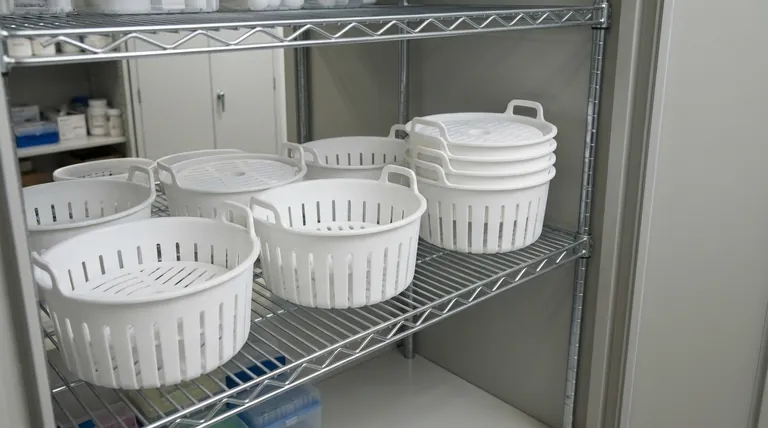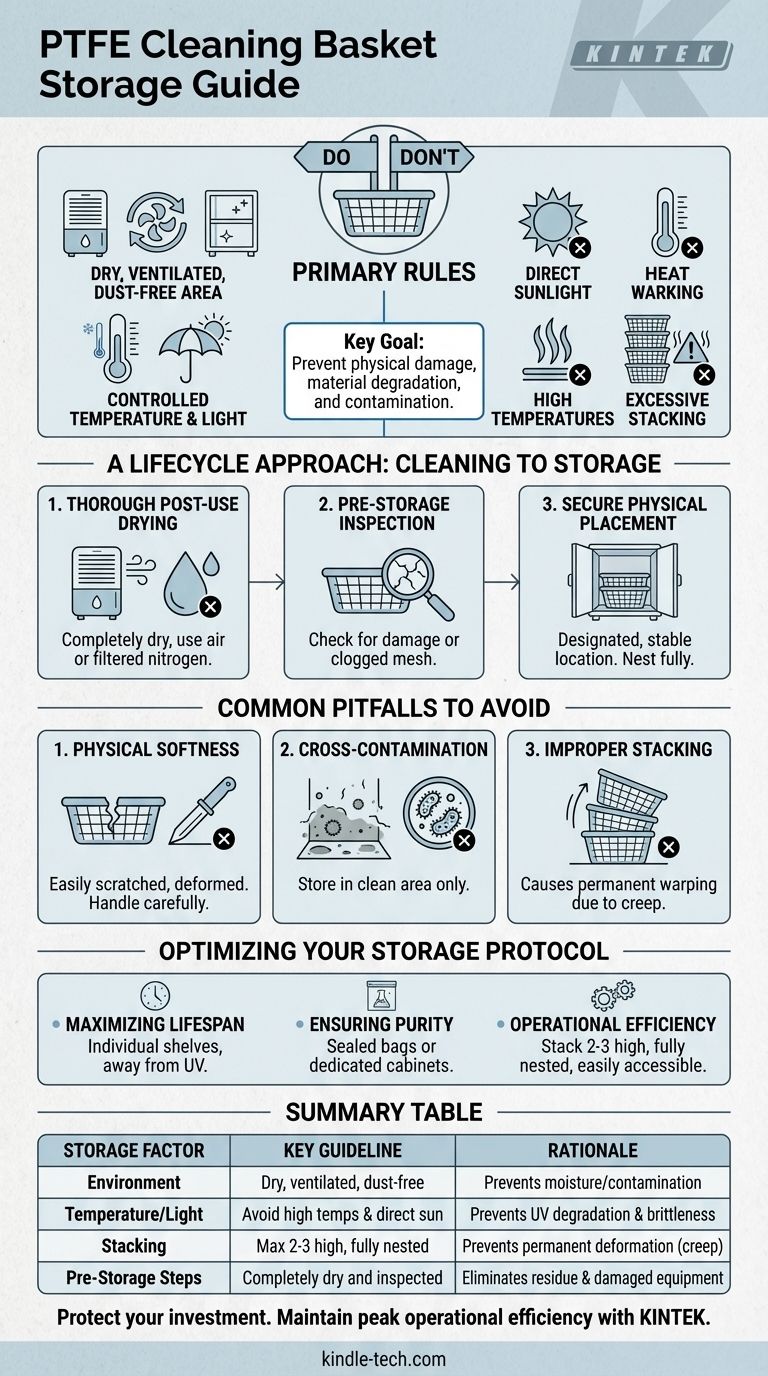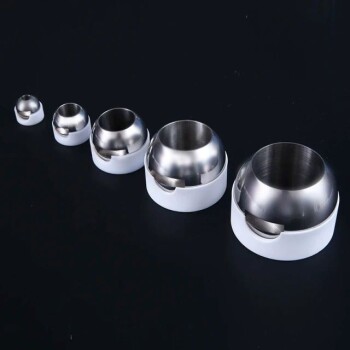To properly store a PTFE cleaning basket, you must place it in a dry, ventilated, and non-corrosive environment. It is crucial to keep it away from direct sunlight and high temperatures to prevent material degradation. While baskets can be stacked to save space, they should not be stacked excessively high, as the sustained pressure can cause permanent deformation.
Storing a PTFE basket correctly is not just about putting it away—it is the final, critical step in a maintenance protocol designed to protect your investment. The primary goal is to prevent physical damage, material degradation, and contamination, ensuring the basket remains reliable for cleaning high-value components.

The Principles of Proper PTFE Storage
Understanding the "why" behind storage guidelines is key to maximizing the lifespan and effectiveness of your equipment. Polytetrafluoroethylene (PTFE) has unique properties that dictate its ideal storage conditions.
Controlling the Environment
PTFE is renowned for its chemical inertness. However, storing it in a dry, ventilated area prevents moisture from being trapped in the mesh, which could harbor contaminants or react with residual cleaning agents. A dust-free location is essential to prevent the basket from re-contaminating sensitive parts in its next use.
Avoiding Thermal and UV Degradation
Although PTFE has a high heat tolerance for use, long-term exposure to high temperatures or direct sunlight (UV radiation) can slowly degrade the polymer. This process can reduce its strength and make the material more brittle over time, compromising the basket's structural integrity.
Preventing Physical Deformation
PTFE is a relatively soft material susceptible to a phenomenon known as creep, which is gradual deformation under sustained pressure. Stacking baskets too high or placing heavy objects on them can cause the frame or mesh to permanently warp, rendering the basket useless.
A Lifecycle Approach: From Cleaning to Storage
Proper storage is the final phase of a larger care cycle. Each step is critical for maintaining the basket's condition.
Step 1: Thorough Post-Use Drying
Before long-term storage, the basket must be completely dry. After its final rinse, allow it to air-dry naturally in a clean area or use a filtered nitrogen gas gun for faster, purer results. Storing a wet basket encourages contamination and potential residue buildup.
Step 2: Pre-Storage Inspection
Perform a quick but careful inspection before putting the basket away. Check for any cracks, deformation, or clogged mesh. Identifying damage at this stage prevents a faulty basket from being used accidentally, which could lead to damaged parts or ineffective cleaning.
Step 3: Secure Physical Placement
Place the clean, dry, and inspected basket in its designated storage location. This should be a clean cabinet or a dedicated shelf. If stacking is necessary, ensure the baskets are fully nested and stable to distribute weight evenly and minimize pressure.
Understanding the Common Pitfalls
Avoiding common mistakes is as important as following the correct procedures. Misunderstanding the material's limitations is a frequent source of premature failure.
The Myth of Indestructibility
While chemically robust, PTFE is physically soft. It is easily scratched by sharp edges and can be deformed by severe impacts or excessive pressure. Never drop the basket or place items with sharp corners inside it without protective wrapping.
The Risk of Cross-Contamination
The primary purpose of a PTFE basket is to facilitate pristine cleaning of sensitive parts. Storing it in an open, dusty, or "dirty" industrial area completely defeats this purpose. The basket is only as clean as the environment in which it is stored.
The Danger of Improper Stacking
The temptation to save shelf space by stacking baskets high is a costly error. The weight can cause the bottom-most baskets to deform beyond repair. The cost of a new basket far outweighs the perceived benefit of a few extra inches of shelf space.
Optimizing Your Storage Protocol
Your specific storage strategy should align with your operational priorities. Use these guidelines to tailor your approach.
- If your primary focus is maximizing equipment lifespan: Store baskets individually on shelves and away from all UV sources to prevent long-term material degradation and deformation.
- If your primary focus is ensuring absolute process purity: Store each dried and inspected basket within a sealed, clean polymer bag or a dedicated, enclosed cabinet to eliminate any risk of dust and airborne contaminants.
- If your primary focus is operational efficiency: Stack baskets no more than two or three high, ensuring they are fully nested and stable, and keep them in a clearly designated, easily accessible location.
Ultimately, treating your PTFE basket as a piece of precision equipment is the key to ensuring its longevity and reliability.
Summary Table:
| Storage Factor | Key Guideline | Rationale |
|---|---|---|
| Environment | Dry, ventilated, dust-free area | Prevents moisture buildup and contamination |
| Temperature/Light | Avoid high temperatures & direct sunlight | Prevents UV degradation and material brittleness |
| Stacking | Stack no more than 2-3 high, fully nested | Prevents permanent deformation from sustained pressure (creep) |
| Pre-Storage Steps | Ensure basket is completely dry and inspected | Eliminates risk of residue buildup and use of damaged equipment |
Ensure your lab's precision cleaning processes remain uncompromised. Proper storage of your PTFE baskets is just one part of maintaining high-quality lab equipment. At KINTEK, we specialize in providing reliable lab equipment and consumables tailored to your laboratory's needs.
Let us help you protect your investment and maintain peak operational efficiency.
Contact our experts today to discuss your specific requirements and discover how KINTEK's solutions can support your lab's success.
Visual Guide

Related Products
- Custom PTFE Teflon Parts Manufacturer for Hollow Cleaning Basket and Rack Carrier
- Custom PTFE Teflon Parts Manufacturer Corrosion Resistant Cleaning Rack Flower Basket
- Custom Machined and Molded PTFE Teflon Parts Manufacturer for Laboratory ITO FTO Conductive Glass Cleaning Flower Basket
- Custom PTFE Teflon Parts Manufacturer for Hollow Etching Flower Basket ITO FTO Developing Glue Removal
- Custom PTFE Wafer Holders for Lab and Semiconductor Processing
People Also Ask
- What is the correct way to place items into a PTFE cleaning basket? Master the Art of Perfect, Repeatable Cleaning
- What should be monitored during the cleaning process when using a PTFE cleaning basket? Ensure Reliable Results & Prevent Damage
- What inspection should be performed on a PTFE cleaning basket before use? A 3-Step Protocol for Safe, Effective Cleaning
- What material is a PTFE cleaning basket made of? Unlocking Superior Chemical and Thermal Resistance
- How should a PTFE cleaning basket be cleaned and dried after use? Ensure Purity and Prevent Cross-Contamination



















